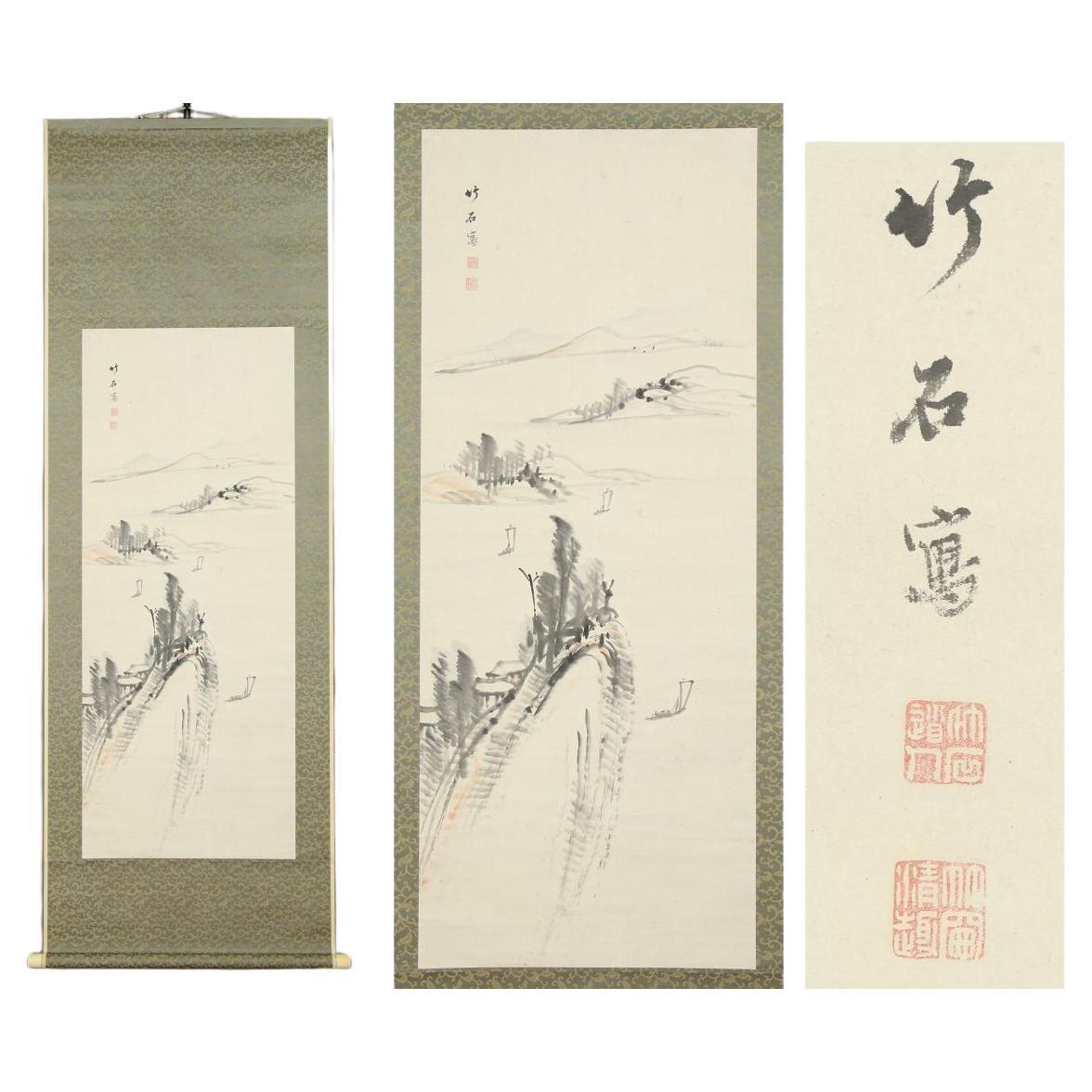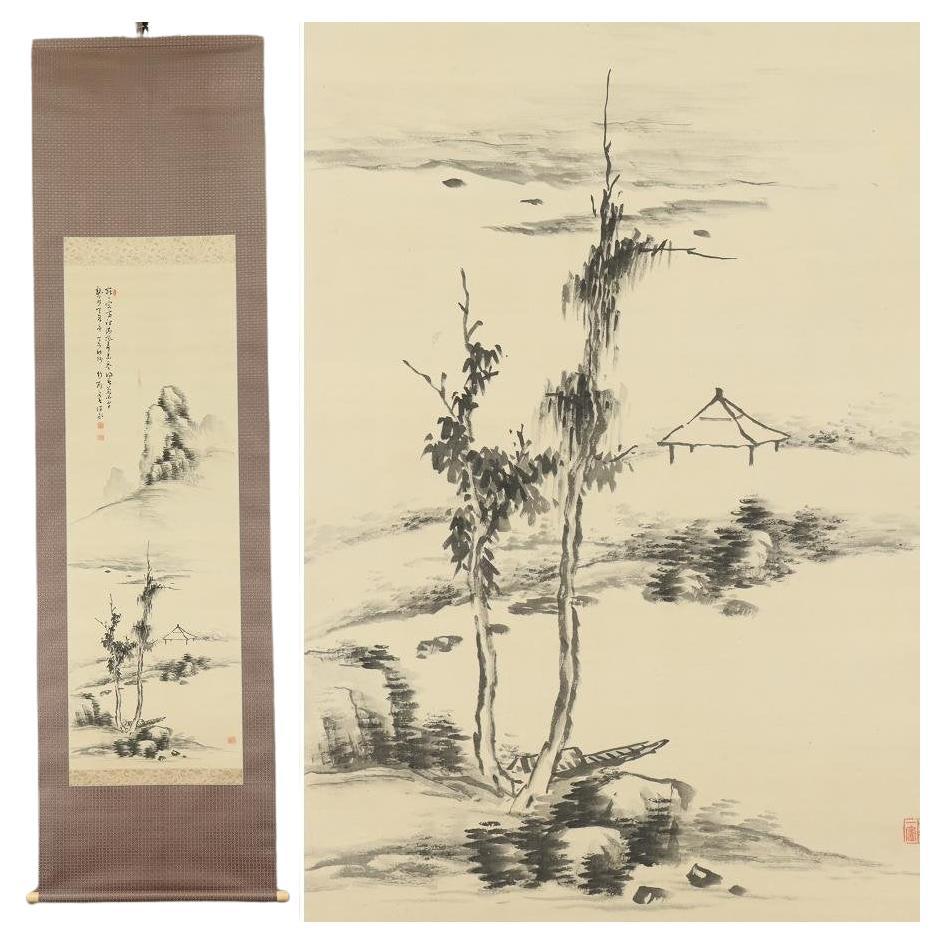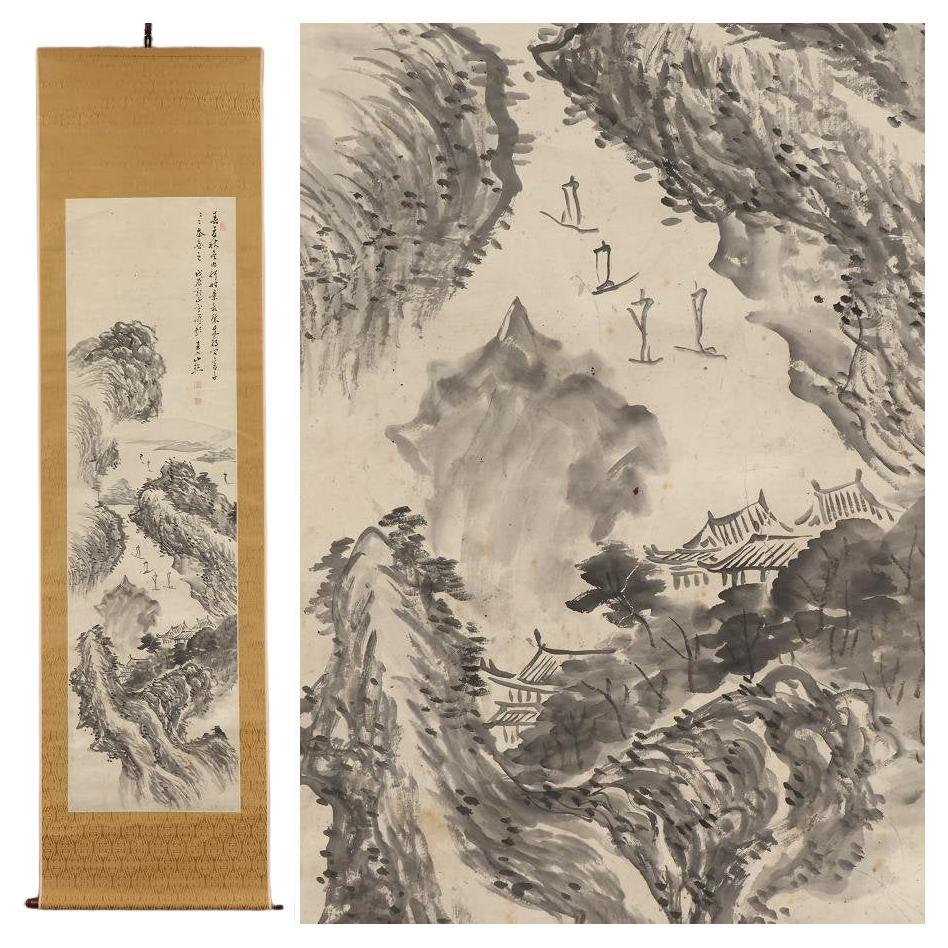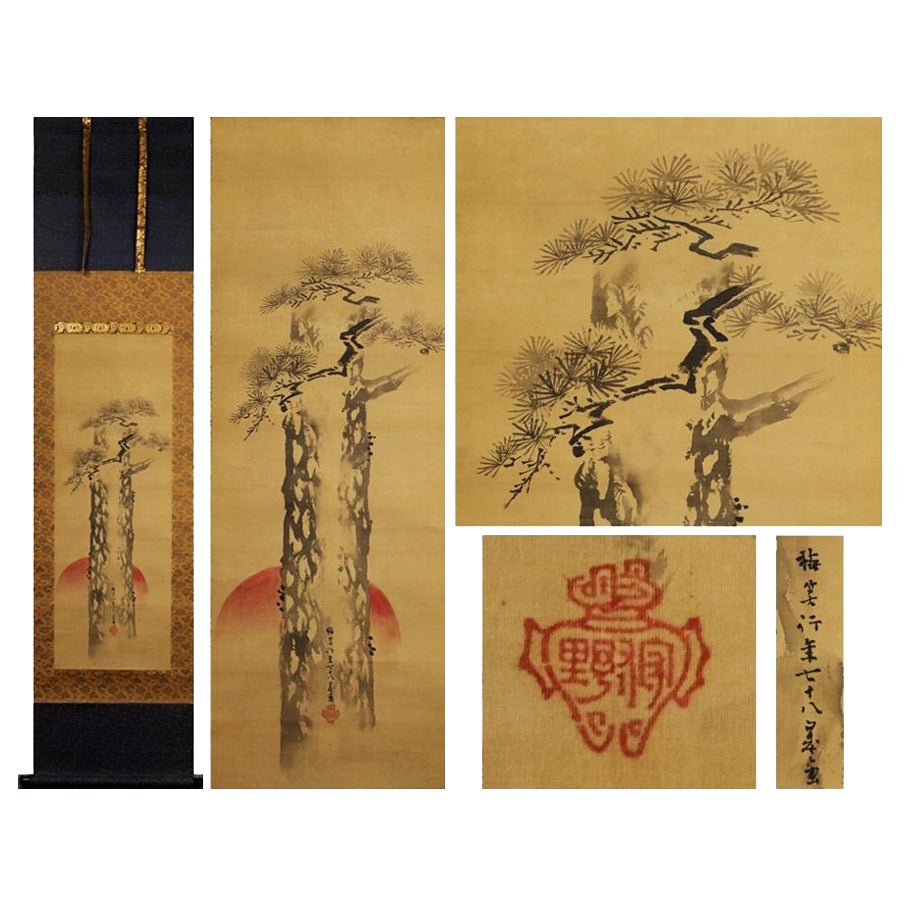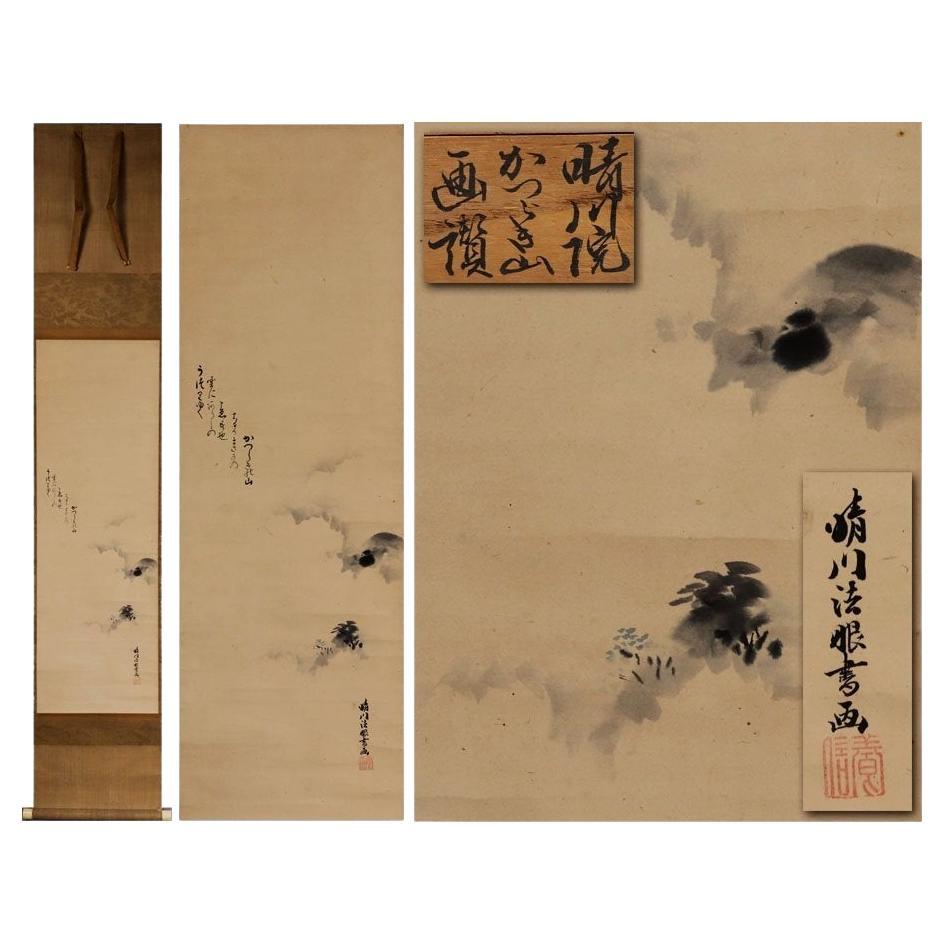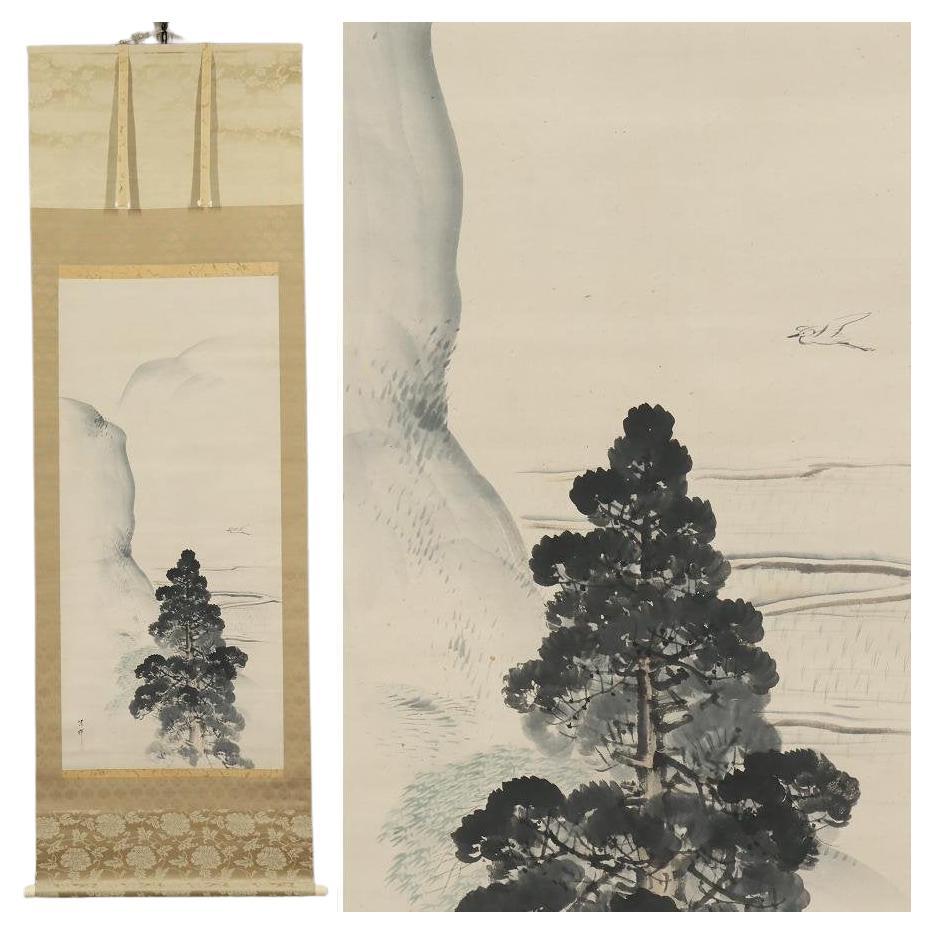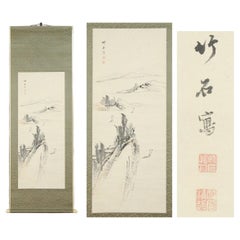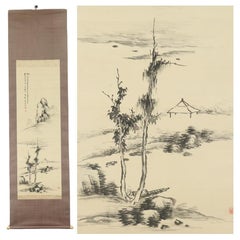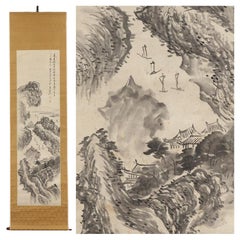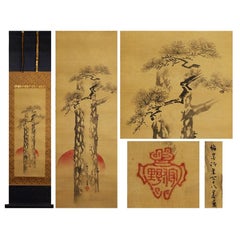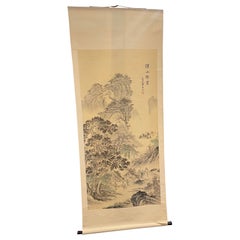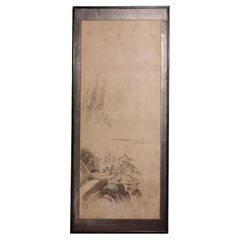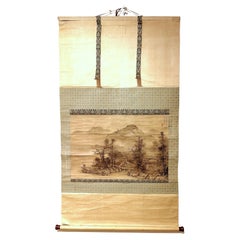Items Similar to Antique Japanese 18th c Edo Scroll Rosetsu Nagasawa Nihonga Landscape Painting
Want more images or videos?
Request additional images or videos from the seller
1 of 5
Antique Japanese 18th c Edo Scroll Rosetsu Nagasawa Nihonga Landscape Painting
$1,515.72
$1,894.6520% Off
£1,128.65
£1,410.8220% Off
€1,278.40
€1,59820% Off
CA$2,082.68
CA$2,603.3520% Off
A$2,330.91
A$2,913.6420% Off
CHF 1,216.56
CHF 1,520.7020% Off
MX$28,425.13
MX$35,531.4220% Off
NOK 15,570.29
NOK 19,462.8620% Off
SEK 14,739.27
SEK 18,424.0920% Off
DKK 9,731.34
DKK 12,164.1820% Off
Shipping
Retrieving quote...The 1stDibs Promise:
Authenticity Guarantee,
Money-Back Guarantee,
24-Hour Cancellation
About the Item
The following is a work of art depicting the ``Horai Landscape,'' a land of peach, created by the master artist
[Rosetsu Nagasawa]
A painter from the late Edo period.
There are conflicting versions of Rosetsu's family origins, but the most credible appears to be that he was born to the family of a low-ranking samurai named Uesugi Hikouemon in the area of modern Kyoto Prefecture. Upon establishing himself as an artist, he changed his name from Uesugi to Nagasawa. He moved to Kyoto in 1781, where he became a student of Maruyama Ōkyo.
Rosetsu was married and had four children, all of whom died in childhood. He adopted his pupil Nagasawa Roshū.
Rosetsu died in 1799, allegedly by murder.[3] He was said to have been poisoned, although others claim he committed suicide. He, his children, and his pupil are buried in a Kyoto cemetery belonging to the Pure Land Sect, although Rosetsu was a lay student of ZenHe was born into the Uesugi family, a retainer of the Yodo domain in Yamashiro Province, and was adopted by the Nagasawa family.
His name is Masakatsu Uo, his written name is Hikei Hikisame, his common name is Kazue, and his other name is Kanshu Fisherman Hikihi.
He learned painting techniques from Okyo Maruyama and developed his own unique style of painting.
He has created many masterpieces with his unique ideas and bold screen compositions.
Died in 1799 at the age of 45
■Book on silk, handpainted
■Condition:
There is age-related discoloration, wear, and some damage.
■Dimensions
Axis dimensions: approx. 187.0cm x approx. 60.5cm.
Main paper dimensions: approx. 129.0cm x approx. 56.0cm.
■Inscription
There are inscriptions and inscriptions as shown.
■Box
box.
- Dimensions:Height: 73.63 in (187 cm)Width: 23.82 in (60.5 cm)Depth: 0.04 in (1 mm)
- Style:Edo (Of the Period)
- Materials and Techniques:
- Period:
- Date of Manufacture:1800
- Condition:Wear consistent with age and use.
- Seller Location:Amsterdam, NL
- Reference Number:Seller: 1001stDibs: LU4863236952462
About the Seller
5.0
Platinum Seller
Premium sellers with a 4.7+ rating and 24-hour response times
Established in 2015
1stDibs seller since 2019
262 sales on 1stDibs
Typical response time: 2 hours
- ShippingRetrieving quote...Shipping from: Amsterdam, Netherlands
- Return Policy
Authenticity Guarantee
In the unlikely event there’s an issue with an item’s authenticity, contact us within 1 year for a full refund. DetailsMoney-Back Guarantee
If your item is not as described, is damaged in transit, or does not arrive, contact us within 7 days for a full refund. Details24-Hour Cancellation
You have a 24-hour grace period in which to reconsider your purchase, with no questions asked.Vetted Professional Sellers
Our world-class sellers must adhere to strict standards for service and quality, maintaining the integrity of our listings.Price-Match Guarantee
If you find that a seller listed the same item for a lower price elsewhere, we’ll match it.Trusted Global Delivery
Our best-in-class carrier network provides specialized shipping options worldwide, including custom delivery.More From This Seller
View AllJapanese Painting 18c Edo Scroll Chikuseki Nagamachi Nihonga Landscape Painting
Located in Amsterdam, Noord Holland
[Authentic Artwork] ◆ Nagamachi Chikuseki ◆ Landscape ◆ Edo Period ◆ Mitsuishi Origin ◆ Kagawa Prefecture ◆ Handwritten ◆ Paperback ◆ Hanging Scroll ◆ k891 ◆ Nagamachi Chikuseki
Explore the artistry of Chikuseki Nagamachi...
Category
Antique 18th Century Edo Paintings
Materials
Silk
$1,800 Sale Price
20% Off
Japanese Nihonga Painting 19th Meiji Scroll Tajika Chikuson Landscape Nanga
Located in Amsterdam, Noord Holland
[Authentic Artwork] ◆ Chikuson Tajika ◆ Autumn Landscape ◆ Master: Naoiri Tanomura ◆ Oita Prefecture ◆ Hand-Painted ◆ Silk Mounted ◆ Hanging Scroll ◆
Delve into the artistry of Chik...
Category
Antique 19th Century Edo Paintings
Materials
Silk
$1,136 Sale Price
20% Off
Japanese Nihonga Painting 19th c Edo Scroll by Tonomura Chokunyu River landscape
Located in Amsterdam, Noord Holland
[Authentic work] ◆Tanomura Chokunyu ◆Ink painting landscape ◆Japanese painting ◆Handpainted ◆ Paper ◆ Hanging scroll ◆
Chokunyu Tanomura
1814 (Bunka 11) - 1907 (Meiji 40)
[Art yearbook appraised value 8 million yen]
"A child prodigy in painting, Tanomura Chokunyu originally modeled himself after the style of the famous Tanomura Chikuden (1777-1835), who had adopted him at the age of eight. After Chikuden's death, Chokunyu took up an intense study of imported Chinese paintings." Paul Berry in: Literati Modern, p.136.) - The certificate box was inscribed by Tajika Chikuson (1864-1922), one of Chokunyu's key disciples.
Around 1840, he studied Confucianism under Kotake Shinozaki in Osaka, deepened his friendships with Heihachiro Oshio and Tessai Tomioka through sencha, and began to be recognized as a painter.
Furthermore, in 1862, he founded and hosted the Seiwan Tea Ceremony (a sencha tea ceremony), which achieved great fame.
In 1868, he moved to Kyoto and participated in the establishment of the Kyoto Prefectural Painting School (opened in 1880), serving as its principal and making efforts to foster the next generation.Furthermore, in 1996, he established the Japan Nanga Association with Tessai and others, and established the Japan Nanga Association, which was established in modern Japan. He made a great contribution to painting and the southern painting...
Category
Antique 19th Century Edo Paintings
Materials
Silk
$1,705 Sale Price
20% Off
Antique Japanese 18th c Edo Scroll [Kano Baisho Nihonga Landscape Painting
Located in Amsterdam, Noord Holland
This is a ``Rising Sun and Pine Tree'' drawn by Kano Baisho.
It is an item with a solemn taste and presence, and I think it would be a good idea to display it at New Year's, the fir...
Category
Antique 18th Century Edo Paintings
Materials
Silk
$3,412 Sale Price
20% Off
Lovely Japanese 18/19th c Edo Scroll Kano Osanobu Nihonga Painting Mountain
Located in Amsterdam, Noord Holland
Kano Osanobu (狩野養信)
Osanobu Kano (born August 18, 1796; died June 12, 1846) was the ninth painter of the Kobikicho Kano School in the Edo period. His common name was Shozaburo. His father was Naganobu KANO, and Tadanobu KANO was his son. His Go (pen name) was Osanobu Seisenin, Kaishinsai, and Gyokusen.
Brief Personal History
He was born the eldest son of Naganobu ISENIN during the Edo period. He was first sent to serve at Edo Castle at the age of 15, and it appears that he was apparently pushed by his father to perform various public tasks for the Kanon School. He kept a diary for 36 years, starting from the day before he first went into service at Edo Castle until the day before he died. The diary is entitles "Official Service Diary" (it consists of 52 volumes that are maintained at the Tokyo National Museum, and 4 volumes that are separately maintained at the different families), and have become the focus of a lot of attention in recent years for the detailed information they present on the daily life and work of a prestigious official painter. The reading of the characters of his name was originally "Takenobu"; however, with the birth of the first son of the Shongun Ieyoshi TOKUGAWA in 1813, whose name was Takechiyo, having a sylable with the same pronunciation of "Take"was deemed to be inappropriate, and was therefore changed to "Osanobu". Because Takenobu died the following year, after which he was referred to as Gyokujuin, Osanobu changed his pen name Gyokusen he had used until that point to Seisenin, in order to avoid using the same Chinese charcter pronounced alike. In 1819, he attained the second highest rank for a Buddhist priest, Hogen, and assumed the role of head of the family after his father passed away in 1828. In 1834 he attained the highest rank for a Buddhist priest, Hoin. He oversaw the rennovation of the wall paintings of Nishinomaru Palace of Edo Castle from 1838 to 1839, and Honmaru Palace of it from 1844 to 1846. It is thought that Osanobu later died due to the fatigue...
Category
Antique 18th Century Edo Paintings
Materials
Silk
$1,705 Sale Price
20% Off
Japanese Nihonga Painting 19th c Edo Scroll by Seiki Yokoyama Landscape Shijo
Located in Amsterdam, Noord Holland
[Authentic work] ◆ Seiki Yokoyama ◆ Landscape ◆ Rural landscape ◆ Japanese painting ◆ Shijo school ◆ Hand-painted ◆ Paperback ◆ Hanging scroll ◆
Seiki Yokoyama
[Art yearbook appra...
Category
Antique 19th Century Edo Paintings
Materials
Silk
$1,231 Sale Price
20% Off
You May Also Like
Japanese Scroll Hand Painting in Black Ink of a Landscape, Early 20th Century
Located in Savannah, GA
Japanese Scroll Hand Painting in Black Ink of a Landscape, Early 20th Century
Category
Early 20th Century Japanese Paintings and Screens
Materials
Paper
Antique Japanese Suibokuga Landscape by Kano Tokinobu, 17th century.
Located in Point Richmond, CA
Antique Japanese Suibokuga Landscape by Kano Tokinobu, 17th century. A sumi-e ink on paper painting illustrating a rocky seaside landscape containing buildings, vegetation and ship masts. The painting with 3 vermillion seals of the artist in the lower left corner. Japanese dry mount paper on a wood frame with thin brocade border silver leafed surround and lacquered wood outer frame.
Condition: Lighter discoloration near the bottom of the painting, various paper restorations, other minor signs of age, wear, stains, otherwise fine condition.
Age: Painting Edo Period, circa 1670. Mounting circa 1985.
Image: 51-1/2 in. x 20-1/2 in. (131cm x 52cm)
Frame: 59-1/4 in. x 25-1/4 in. (150cm x 64cm)
Weight: 6 lbs.
Provenance:
with Honeychurch Antiques...
Category
Antique 1670s Japanese Edo Paintings and Screens
Materials
Paper
Japanese Landscape Painting, Hanging Scroll Painting
Located in Greenwich, CT
Japanese scroll painting of landscape painting depicted village along the riverside in the mountains with fisherman
Ink and color on silk
Overall size...
Category
Antique 19th Century Japanese Paintings and Screens
Materials
Silk
Japanese Painting of Mountain and village, Hanging Scroll
Located in Greenwich, CT
Japanese scroll painting depicted village in the mountain
Ink and paper. Artist signed
Overall size: 43" height. 21" width
Image size: 10.8" height. 16" width
Category
Vintage 1940s Japanese Paintings and Screens
Materials
Paper
Japanese Silk Scroll Painting of Moneys Edo Period Mori Tetsuzan
Located in Atlanta, GA
A Japanese mounted vertical hanging scroll painting by Mori Tetsuzan (Japanese, 1775-1841) circa 19th century Edo period. The watercolor and ink on silk ...
Category
Antique 19th Century Japanese Japonisme Paintings and Screens
Materials
Silk, Paper
Chinese Sun Yunqiao 孫雲樵 Autumn Mountain Landscape Silk Scroll Painting 59"
Located in Dayton, OH
Mid to early century Chinese wall hanging scroll, painted with a pair of figures riding donkeys, crossing a bridge against a landscape of mountains and gnarled pines; by artist Sun Y...
Category
20th Century Chinese Chinoiserie Paintings and Screens
Materials
Wood, Paint, Paper
$1,000 Sale Price
20% Off
More Ways To Browse
Japanese Scroll Landscape Painting
Kyoto Screens
18th Century Japanese Screens
Edo Samurai
Antique Samurai
Japanese Fisherman
Kyoto Silk Painting
18th Century Japanese Silk Painting
Samurai Box
Japanese Screen Samurai
Maruyama Okyo
18th C Japanese Screen
Chinese Tapered Cabinet
Chinoiserie Wood Panel Art
Circular Art Deco Cabinet
Enamel Fox
Eve Apple
Folding Table Screen
